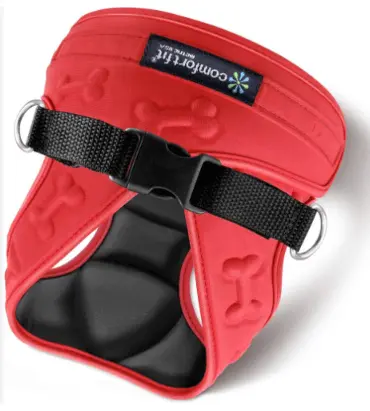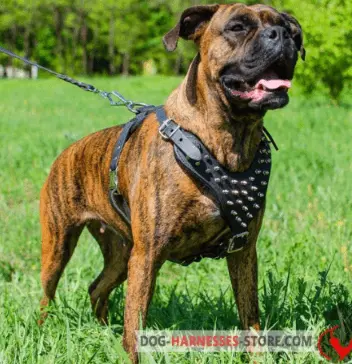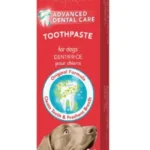Image: Dog Harnesses Store
Does your boxer dog enjoy outdoor activities? There is no doubt about boxers’ strength. Managing this energetic breed requires the right approach. Nothing that can’t be solved by getting the best harness for boxer dogs.
Harnesses offer a solution that engages your dog’s full body for full control. Unlike collars, they are designed to go around your dog’s chest and shoulders rather than just their neck. They handle strain concerns for owners who worry about their dogs’ neck health when pulling on the leash.
What used to be considered optional dog gear has now become the preferred choice for many dog owners. A harness happens to be one of the essential dog gear. This blog offers a detailed review and guidance on selecting the best harness for boxer dogs.
Should Boxers Wear a Harness?
Even well-behaved dogs can get startled and pull themselves too hard, triggering an injury. Unfortunately, the high energy of boxer dogs is a reason why some dog owners consider boxers the worst dogs. Harnesses help prevent such accidents. Here are reasons why your Boxer should wear a harness:
It Offers Full Control
Most large breeds tend to pull on the leash or become overly excited in unfamiliar settings. A harness allows you to fully guide your furry companion more efficiently, preventing unruly behavior.
To Prevent Injuries
First, using a dog harness notably reduces the risk of neck and spine injuries. Harnesses evenly distribute the leash force across the dog’s chest, preventing neck and spine injuries. Additionally, harnesses provide a comfortable alternative for dogs with existing spine and neck conditions.
Preventing Escapes
Every dog owner experiences peace of mind knowing that their dog is secure. An ideal harness snugly fits around your boxer dog’s body. Therefore, it makes it hard for them to slip out.
Distinguishing Between a Harness and a Collar
Both harnesses and collars serve a purpose when managing boxer dogs during walks. Harnesses encircle the dog’s torso, shoulders, and chest, distributing leash pressure evenly.
Advantages of harnesses:
- They offer comfort to dogs as pressure is evenly distributed across the body.
- Provide security, especially for escape artists, as dogs struggle to wiggle out of them.
- Front-clipped harnesses discourage pulling during leash training.
- Reduce the risk of throat-related injuries, neck issues, and tracheal collapse.
- It is ideal for dogs with back pain, as pressure is spread over the shoulders, chest, and back.
- They enable dogs with back pain, as pressure is spread over shoulders, chest, and back.
- They are suitable for long-bodies breeds, dogs with spinal problems, and those with orthopedic conditions.
- A harness serves as an effective training aid for dogs.
Disadvantages of harnesses
- Finding the right fit for your canine companion can be challenging, risking discomfort or escape.
- Dogs may need time to acclimate to wearing a harness; it can be highly uncomfortable.
- Displaying pet ID tags can be problematic with some harnesses—leading pet owners to resort to using both a collar and harness simultaneously.
- Certain harness designs with leash attachments at the back might encourage pulling behavior.
- Harnesses can be uncomfortably warm for dogs, particularly in the summer.
Collars
Conversely, collars are worn around the neck and are commonly used for leash attachment and ID tags, offering versatility in size and style.
Advantages of Dog Collars
- Dog collars offer a wide range of colors, styles, and materials options.
- They provide a convenient way to attach ID tags, ensuring essential information like the dog’s name and contact number is easily visible.
- Collars are easy to put on and off, allowing dogs to wear them whenever necessary.
Disadvantages of Dog Collars
- Puppies require frequent collar checks as they grow rapidly.
- There is a risk of accidental choking if a dog gets caught on an object by its collar.
- Excessive pulling on a leash can strain the dog’s trachea, potentially leading to irritation and injuries.
Is a harness superior to a collar? While a dog harness often proves advantageous in various scenarios, collars offer their benefits, too. Thus, your dog’s individual preference should factor into your decision-making process.
What Size Harness for a Boxer?
The PDSA 2019 PAW report revealed that approximately 25% of shelter dog adopters state leash pulling as their major concern. Selecting the appropriate dog harness is essential to ensure your Boxer’s safety, comfort, and effective control during walks. This helps minimize the chances of injuries or escape while ensuring enjoyable outings for the dog and the owner.
What Size is the Right Size?
Relying solely on breed to choose a harness may lead to purchasing an ill-fitting product. It’s important to note that certain breeds are bred to extreme sizes, posing challenges in finding suitable harnesses. For instance, boxers can weigh up to 160 pounds, often exceeding the capacity of standard harness brands.
If you are purchasing a harness for a puppy, it is equally important to consider size. Given the rapid growth of boxer dogs, the puppies are likely to outgrow multiple harnesses before reaching full size.
Similar to human clothing, different companies selling harnesses have varying size parameters, making it important to consider individual dog measurements. For example, what one company labels as small might not align with a small size from another company.
You must measure your dog’s girth and weight to find their ideal harness size. Here’s how to do it:
How to Measure Your Dog’s Girth
Start from just behind the shoulders, including the deepest part of the chest. That should typically go behind the elbows. Wrap a tape measure around the chest, beginning at the withers and going around the ribcage at its widest point.
How to Weigh Your Dog
Weighing your dog is as simple as using a regular scale. Step on the scale alone, then step on it again while holding your dog. Subtract your weight from the combined weight to find your dog’s weight.
Once you have the measurements, you can consult the boxer harness size chart below to find the best fit for your dog. Here is a general chart size chart to get you started:
| Size | Circumference (Inches) | Weight (Kgs) |
| Small | 18-22 | 15.2- 18.1 |
| Medium | 22-26 | 18.1- 27.2 |
| Large | 26-32 | 27.2- 36.3 |
| Extra Large | 32-38 | 36.2- 60.0 |
How do I Choose a Good Dog Harness?

Image: Amazon
Did you know that not all dog harnesses are made equally? Selecting one that works well for your dog despite the wide selection in pet stores and online is crucial. Below are several factors to consider when choosing a harness for your dog:
Compatibility with the Leash
Choose a harness that is compatible with your leash. There are three main types to consider: front clip, back clip, and multi-clip. Your choice depends on your preference and your dog’s needs.
- Front Clip: Offers control over behaviors like jumping and pulling.
- Back Clip: It is comfortable and easy to use but provides limited control over your dog’s direction.
- Multi-clip combines front and back clips, often with a handle for close control. Additionally, it offers versatility and is great for multi-leash training.
Select Ideal Materials
Harnesses offer better control during walks. They reduce messes but require cleaning, particularly ones that have padding. Short-haired dogs benefit from padded harnesses to prevent skin irritation.
Some prefer leather for its polished feel and durability, while others prefer nylon for easy washing.
Enhanced Visibility
Consider a harness with reflective material to stay visible to traffic during late or early walks. It is essential to prioritize safety for both you and your dog.
Find the Right Fit
Visit a pet store that lets you try different harnesses on your dog before purchasing. These stores provide treats, making it an ideal setting to assess which harness fits your dog best. How do I Choose a Good Dog Harness?
The Best Harness for Different Situations and Dog Types
Different types of dogs have unique needs depending on their breed and walking behaviour. Below is a breakdown of various situations you might encounter and the best harness suited for them:
- Dogs Prone to Pulling: Consider a front-clip harness if your dog is prone to pulling. If your strong puller still struggles, consider a head collar as an alternative.
- Escaping Dogs: It is more likely for a boxer to escape. Ensure you get the escape-proof harness. This harness tightens when the dog pulls, hence preventing escapes.
- Unique Body Types: Harnessing dogs with distinctive proportions requires harnesses with adjustable straps for a proper fit.
- Puppies: For puppies, durable, lightweight, and easily adjustable harnesses are ideal. Such harnesses can accommodate their growing bodies.
- Dogs that Chaf: For chafing dogs, prioritize a well-fitted harness with adjustable straps for full-range motion.
Best Items for Boxer Dogs
While a dog can technically survive with food, shelter, and water, providing a boxer with extra supplies is essential. Below is a list of supplies that go hand-in-hand with harnesses that every boxer dog should have access to:
- Harnesses: Boxers are powerful dogs, and a well-fitting harness is crucial for comfortable walks and proper training. Harnesses distribute pressure evenly across their chest and shoulders, preventing strain on their necks. Opt for a padded harness that’s adjustable for a perfect fit.
- Leashes: A leash should be sturdy enough to handle your Boxer’s strength yet comfortable. A standard 6-foot leash is a good starting point for walks and training. Consider a retractable leash for controlled freedom in safe areas.
- Bowls: Puppies will need smaller bowls initially, transitioning to adult-sized ones as they grow. Stainless steel or ceramic bowls are ideal for their durability and ease of cleaning. Opt for bowls with a non-slip base to prevent spills and messy mealtimes.
- Beds: Boxers love to lay on couches. Provide a comfortable bed that’s large enough for them to sprawl out. Consider their age and needs. A supportive orthopaedic bed might be beneficial for senior Boxers. Easy-to-wash covers are a must for maintaining cleanliness, especially for droopy boxers.
- Toys: Energetic dogs need mental stimulation. Interactive toys like puzzle feeders and chew keep children engaged and prevent boredom. Provide a variety of textures and types of toys to cater to their chewing preferences. Remember to choose toys that are durable and the right size to prevent choking hazards.
Top Picks: Best Harnesses for Boxers
Below is a review of the three top picks for boxer harnesses:
ShawnCo Essential Harness
Designed for ease of use, ShawnCo Essential Harness is effortlessly put on and taken off. Therefore, it is ideal for different activities. This harness is crafted with durable materials, including rings and a soft mesh underside.
The ShawnCo harness is an all-weather harness that ensures all-day comfort and long-lasting use. It is fully adjustable to cater to small and large boxers. Additionally, it has reflective elements that enhance nighttime visibility.
SlowTon No-Pull Dog Harness
Treat your Boxer with a comfortable walking experience with the SlowTon No-Pull Dog Harness. It is a sponge-filled anti-pull dog harness to eliminate stress on your dog’s neck. Its luxurious sponge filling ensures maximum comfort for dogs that pull too much.
This harness is easy to use because it features two fast-release buckles for effortless on and off. Its top handle provides extra control when needed, while its light design guarantees easy cleaning.
Copatchy No-Pull Reflective Adjustable Dog Harness
The Copatchy No-Pull Reflective Adjustable Dog Harness is the budget-friendly option every boxer dog owner requires. It has rings that allow leash attachment with a front clip that discourages pulling.
Its vertical handle evenly distributes pressure, enhancing control and comfort. It is constructed with a scratch-resistant fabric that ensures breathability and durability. With easy-to-use buckles and adjustable straps, it offers convenience and security for your Boxer.
How Do You Know if a Harness Fits a Dog?
A well-fitting harness is essential for comfortable walks, proper training, and overall safety for your Boxer. Here’s how to ensure your harness isn’t too loose or too tight:
The Two-Finger Test
Slide two fingers comfortably between the harness straps and your dog’s body. This applies to both the chest and neck areas. You want a snug fit that offers security without restricting movement. The harness is likely too tight if you can’t fit two fingers in. Conversely, if your fingers move freely with extra space, it’s too loose, and your dog might slip out.
Checking for Movement and Chafing
Once the harness is on, gently run your hands over your dog’s chest and shoulders. The harness shouldn’t dig in or cause any chafing. Look for any signs of discomfort, such as your dog pawing at the harness or trying to back out of it.
With the harness secured, feel around your dog’s shoulders. Can you comfortably move their front leg forward and backward without the harness restricting their natural range of motion? A properly fitted harness should not restrict your dog’s stride.
Training Tips for Boxers
Boxers are intelligent and eager to please, but their energetic nature can sometimes lead to unruly behavior. The key to successful Boxer training lies in positive reinforcement methods. Reward good behavior with praise, lean treats, or their favorite toy. This motivates them to repeat the desired action and builds a strong positive association with training.
Leash Training
Leash training goes hand-in-hand with harness use. Boxers can be strong pullers; a harness helps distribute the pressure comfortably while you train them to walk calmly on a leash. Start with short training sessions in a quiet, distraction-free area.
Reward your Boxer for loose leash walking with treats or praise. If they pull, stop walking and wait for them to return to your side before continuing. Be patient and consistent. Positive reinforcement and leash training will help reduce pulling behavior and make walks enjoyable for both of you.
Conclusion
Equipping your Boxer with the right harness is not just about walks. It is about their overall comfort, safety, and training success. A well-fitting harness distributes pressure evenly and prevents neck and spine injuries. It allows for a full range of motion during walks and playtime.
With the right gear, positive reinforcement training, and plenty of love, your Boxer will be ready for countless walks and adventures together.





